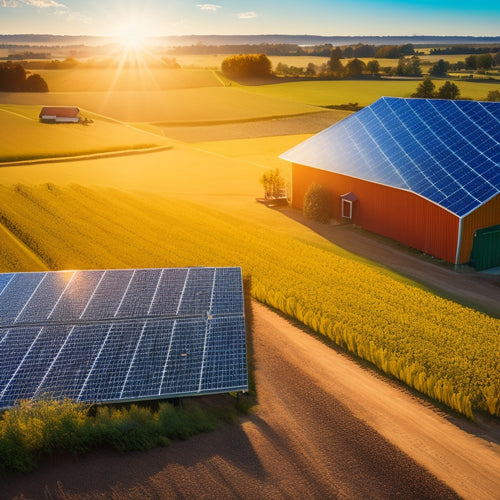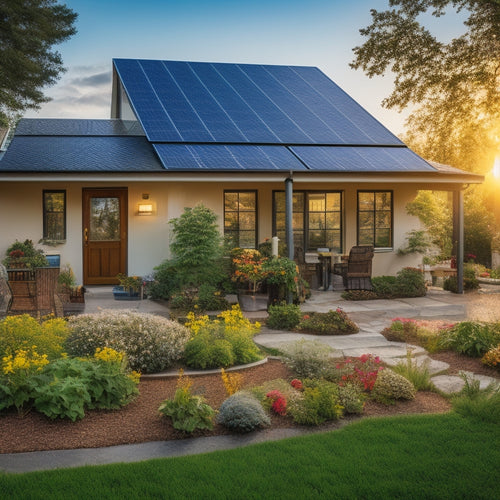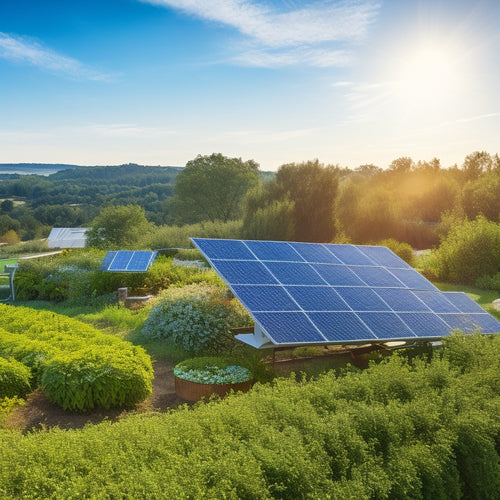
The Best Residential Solar Systems for Energy Efficiency
Share
You're looking for a residential solar system that maximizes energy efficiency, and with the right combination of high-efficiency panels, optimized inverters, and smart monitoring, you can greatly reduce your energy bills and carbon footprint. Top-rated solar panel brands like SunPower, Panasonic, and LG Solar offer high-efficiency panels with low temperature coefficients, ensuring performance in hot climates. Inverters like string inverters, microinverters, and power optimizers convert DC power to usable AC power, while energy consumption analysis determines energy needs. By understanding these components and features, you'll be on your way to designing an efficient solar system that meets your energy needs - and there's more to investigate to get the most out of your investment.
Key Takeaways
- High-efficiency solar panels from top-rated brands like SunPower and Panasonic maximize energy savings and ROI.
- Choosing the right inverter technology, such as string inverters or microinverters, optimizes energy production and minimizes loss.
- Key system components, including solar arrays and energy consumption analysis, are crucial for designing efficient solar systems.
- Energy efficiency features like MPPT technology and grid tie functionality help reduce energy bills and increase savings.
- Proper maintenance and monitoring of solar systems ensure peak energy production and extend their lifespan.
Top-Rated Solar Panel Brands
As you contemplate investing in a residential solar system, selecting a top-rated solar panel brand is essential to ascertain maximum energy efficiency and a dependable return on investment. You want to confirm that your solar panels can convert sunlight into electricity at the highest possible rate.
Solar panel efficiency is a critical factor in this regard, with higher-efficiency panels generating more power per unit area. When comparing brands, look for those that offer high-efficiency solar panels with low temperature coefficients. This means they can maintain their efficiency even in hot climates.
Leading brands like SunPower, Panasonic, and LG Solar offer high-efficiency solar panels with efficiencies ranging from 20% to 22%. Other notable brands like Trina Solar and Hanwha Q CELLS offer high-efficiency panels at competitive prices.
When making a brand comparison, consider factors like warranty, durability, and customer support in addition to solar panel efficiency. By selecting a top-rated solar panel brand, you can maximize your energy savings and enjoy a reliable return on investment.
Residential Solar System Types
You're likely familiar with the different types of solar panels available for residential use, but it's crucial to understand the specific characteristics of each.
Monocrystalline solar panels, known for their high efficiency and durability, are a popular choice among homeowners.
Thin-film solar cells, on the other hand, offer a more affordable option with lower efficiency rates, making them suitable for larger installations.
Monocrystalline Solar Panels
By the dawn of the 21st century, monocrystalline solar panels had emerged as a premier choice for residential solar systems, boasting unparalleled efficiency and reliability.
You're likely considering them for your home, and for good reason. Monocrystalline solar panels offer superior performance and a longer lifespan compared to other types of solar panels.
Here are some key benefits you can expect from monocrystalline solar panels:
-
Higher monocrystalline efficiency: They convert sunlight into electricity at a higher rate, typically between 15% to 20%, resulting in more power per hour of sunlight.
-
Longer monocrystalline lifespan: With a lifespan of 25 years or more, you can rely on them to provide clean energy for decades to come.
-
Better low-light performance: Monocrystalline solar panels perform well even in low-light conditions, making them ideal for areas with partial shading or limited sunlight.
-
Durability and weather resistance: They're built to withstand harsh weather conditions, including heavy rain, hail, and extreme temperatures.
-
Warranty and maintenance: Most manufacturers offer a 25-year warranty, and they require minimal maintenance, giving you peace of mind and protection for your investment.
Thin-Film Solar Cells
While monocrystalline solar panels excel regarding efficiency, they're not the only option for residential solar systems. You may also consider thin-film solar cells, which offer a unique set of advantages.
One of the primary thin film advantages is their lower production cost, making them a more affordable option for homeowners. Additionally, thin-film solar cells are more flexible and lighter than traditional solar panels, making them easier to install and handle. They're also better suited for hot climates, as they perform relatively well in high-temperature conditions.
However, you should be aware of the thin film limitations. Thin-film solar cells typically have lower efficiencies than monocrystalline solar panels, resulting in more space required to generate the same amount of power.
They're also more prone to degradation over time, which can affect their overall performance. Despite these limitations, thin-film solar cells remain a viable option for residential solar systems, especially for those looking for a more budget-friendly solution.
Energy Efficiency Features
Optimizing energy efficiency is a top priority for homeowners installing residential solar systems, and that's where energy efficiency features come into play.
You want to maximize your solar efficiency and get the most out of your renewable energy investment. Energy efficiency features are designed to help you do just that.
Some key energy efficiency features to look for in a residential solar system include:
-
High-efficiency solar panels: These panels are designed to convert a higher percentage of sunlight into usable electricity, resulting in more power per hour of sunlight.
-
Smart inverters: These advanced inverters optimize energy production and reduce energy loss, ensuring you get the most out of your solar array.
-
MPPT (Maximum Power Point Tracking): This feature helps your system operate at its maximum power potential, even in varying sunlight conditions.
-
Energy monitoring and tracking: This feature allows you to keep tabs on your energy production and consumption in real-time, making it easier to identify areas for improvement.
-
Grid tie functionality: This feature enables your system to feed excess energy back into the grid, reducing your energy bills and increasing your overall solar efficiency.
Key System Components Explained
Two primary components form the backbone of a residential solar system: the solar array and the inverter. You'll want to understand how these components work together to maximize your energy efficiency.
The solar array is made up of photovoltaic (PV) panels that convert sunlight into electrical energy. To guarantee optimal performance, it's imperative to conduct an energy consumption analysis to determine your energy needs and size your solar system accordingly. This involves evaluating your energy usage patterns, including your daily energy consumption and peak energy demand.
The inverter plays a significant role in converting the DC power generated by the solar array into AC power, which is usable in your home. There are different types of inverters available, including string inverters, microinverters, and power optimizers.
Each has its advantages and disadvantages, so it's important to choose the right one for your solar system. By understanding the functions and capabilities of these key components, you'll be better equipped to design and install a residential solar system that meets your energy needs and provides maximum energy efficiency.
Installation and Maintenance Costs
Installing a residential solar system requires a significant upfront investment, which can be a major deterrent for many homeowners. However, understanding the installation and maintenance costs can help you make an informed decision about investing in a solar system.
When it comes to installation, you'll need to take into account the following factors:
-
Installation timelines: The time it takes to install a solar system can vary depending on the complexity of the project, the size of the system, and the number of installers.
-
Labor costs: The cost of hiring a professional installation team can range from $2,000 to $5,000 or more, depending on the location and the installer's experience.
-
Permits and inspections: You'll need to factor in the cost of obtaining necessary permits and undergoing inspections, which can add up to $1,000 or more.
-
Mounting and tracking systems: The type of mounting and tracking system you choose can affect the overall cost of the installation.
-
Local incentives: Check if there are any local incentives or rebates that can help offset the installation costs.
When planning for maintenance, you'll need to take into account the cost of regular cleaning, inspections, and potential repairs.
A well-maintained system can promote peak energy production and extend the system's lifespan.
Inverter Technologies Compared
As you evaluate residential solar systems, you'll encounter three primary inverter technologies: string inverters, microinverters, and power optimizers.
Each has its advantages and benefits, which you'll want to take into account when selecting the right system for your energy efficiency goals.
String Inverter Advantages
When it comes to residential solar systems, utilizing maximum energy efficiency relies heavily on the inverter technology used. As you investigate your options, you'll likely come across string inverters, a popular choice among homeowners.
String inverters offer several advantages that make them an attractive option for those seeking to optimize their energy output.
Some of the key benefits of string inverters include:
-
Higher string inverter efficiency: String inverters boast high conversion efficiency rates, ensuring that more of the sun's energy is converted into usable power for your home.
-
String inverter reliability: With fewer components and a simpler design, string inverters are less prone to failure, reducing the risk of downtime and maintenance costs.
-
Cost-effectiveness: String inverters are generally more affordable than other inverter technologies, making them a more accessible option for homeowners on a budget.
-
Easy monitoring and maintenance: String inverters often come with built-in monitoring capabilities, allowing you to track your system's performance and identify any issues quickly.
-
Scalability: String inverters can be easily scaled up or down to accommodate varying system sizes, making them a versatile option for homeowners with unique energy needs.
Microinverter Benefits Explained
You've likely considered string inverters for your residential solar system, but it's also important to investigate microinverters, another popular inverter technology.
Microinverters offer several benefits that make them an attractive option for homeowners seeking energy efficiency. One major advantage is their ability to optimize energy production at the individual panel level. This means that if one panel is shaded or underperforming, the others can still operate at maximum capacity, resulting in higher overall energy output.
Microinverters also boast higher efficiency rates compared to string inverters, with some models achieving efficiencies of up to 96%. This increased efficiency translates to more power harvested from your solar panels.
Additionally, microinverters are designed to provide individual panel monitoring, allowing you to identify and troubleshoot issues quickly. This feature enhances microinverter reliability and reduces downtime.
Moreover, microinverters are often designed with built-in safety features, such as arc-fault detection and ground-fault protection, to guarantee a safe and reliable energy supply.
Power Optimizer Features
Three key inverter technologies are vying for dominance in the residential solar market: string inverters, microinverters, and power optimizers. As you consider which technology to choose, you'll want to examine the benefits of power optimizers.
These devices are installed at each solar panel, allowing for individual panel monitoring and optimization. This leads to improved solar performance and energy savings.
Power optimizers offer several advantages, including:
-
Improved efficiency: Optimizers guarantee that each panel operates at its maximum potential, resulting in increased energy production.
-
Enhanced system reliability: With individual panel monitoring, you'll be alerted to any issues, allowing for quicker troubleshooting and maintenance.
-
Increased installation flexibility: Power optimizers enable you to install solar panels in partial shade or with varying orientations, expanding your installation options.
-
Cost effectiveness: Optimizers can be more cost-effective than microinverters, while still providing many of the same benefits.
-
Future technology advancements: Power optimizers are designed to be compatible with future technology advancements, assuring your system remains up-to-date and efficient.
Battery Storage Options Available
Several battery storage options are available to homeowners looking to optimize their residential solar systems for energy efficiency. You can choose from a range of home battery technologies that cater to your specific energy storage needs.
Lithium-ion batteries, for instance, offer high energy density and long lifetimes, making them a popular choice for residential solar systems. Other options include lead-acid batteries, which are more affordable but have lower energy density, and flow batteries, which are well-suited for long-duration energy storage.
When selecting a battery storage solution, consider factors such as your energy usage patterns, the size of your solar panel system, and your budget.
You'll also want to evaluate the battery's depth of discharge, round-trip efficiency, and warranty period. Some energy storage solutions, like the Tesla Powerwall, offer advanced features like smart grid connectivity and load shifting.
Government Incentives and Rebates
Take advantage of government incentives and rebates to offset the upfront cost of installing a residential solar system. As you consider investing in a solar panel system, you'll want to investigate the various incentives available to you. These incentives can greatly reduce the overall cost of going solar.
Some of the key government incentives and rebates you should be aware of include:
-
Federal Tax Credits: You can claim a federal tax credit of up to 26% of the total cost of your solar panel system.
-
State Rebates: Many states offer rebates for solar panel installations, which can range from a few hundred to several thousand dollars.
-
Net Metering: This program allows you to sell excess energy back to the grid and receive a credit on your utility bill.
-
Property Tax Exemptions: Some states exempt solar panel systems from property tax, which can save you money on your annual property tax bill.
-
Sales Tax Exemptions: A few states also exempt solar panel systems from sales tax, reducing the upfront cost of your system.
Frequently Asked Questions
Can I Install Solar Panels on a Rented Property?
You can install solar panels on a rented property, but it's vital to negotiate a tenant agreement with your landlord, considering solar panel leasing options to guarantee a mutually beneficial arrangement that suits both parties.
Do Solar Panels Work During Power Outages?
You're probably thinking solar panels will save you from power outages, but ironically, they won't - unless you have a battery backup, which enhances solar panel efficiency and provides energy storage for when the grid goes dark.
Are Solar Panels Damaged by Hail or Extreme Weather?
You're wondering if solar panels can withstand harsh weather conditions. Rest assured, most modern solar panels are designed with hail resistance and weather durability in mind, so they can survive extreme weather events without suffering significant damage.
Can I Sell Excess Energy Back to the Grid?
You generate excess energy, and now you're wondering if you can sell it back to the grid. Fortunately, with net metering benefits, you can do just that, earning energy credits through policies that let you offset future consumption.
Do Solar Panels Increase My Property's Value?
You're wondering if solar panels enhance your property's value; research suggests they do, increasing it by up to 17%. During a property appraisal, your solar investment is factored in, potentially leading to a higher selling price or increased refinancing options.
Conclusion
As you weigh your options for a residential solar system, remember that the right combination of energy-efficient features and quality components can make all the difference. For instance, the California-based Smith family saw their energy bills drop by 90% after installing a 5-kilowatt system with high-efficiency panels and a smart inverter. By choosing a top-rated system that suits your needs, you can maximize your energy savings and minimize your carbon footprint.
Related Posts
-

Off-Grid Solar Solutions for Sustainable Farming
Off-grid solar solutions can revolutionize your farming operations by providing energy independence and significant c...
-

How to Achieve Energy Independence at Home
To achieve energy independence at home, start by investing in renewable energy sources like solar panels, wind turbin...
-

Green Energy Alternatives for Independent Living
To enhance your independent living, consider green energy alternatives like solar panels and wind turbines. These opt...


